This is the second part of a series of posts seeking to describe and analyze the 7.62mm Light Rifle concept promoted by the Americans, and subsequently adopted by NATO in various forms. This series will cover development from before World War II to the present day, but will focus primarily on the period from 1944-1970, which constitutes the span of time from the Light Rifle’s conception until its end in the United States with the standardization of the M16.
You can read the other parts of the series by following the links below:
- Light Rifle 1.5: A Clarification (this was written after Part I, but should be read first)
- The Rise And Fall Of The Light Rifle, Part I: Prologue
- Improving The Deadliest Rifle In The World: The M1E Series
- Light Rifle, Part IV: The M1 Garand Learns To Rock And Roll
With the adoption of the M1 rifle, the United States Army had leaped ahead in the field of infantry rifle technology. The Garand provided the individual United States soldier with unprecedented firepower on the battlefield, while maintaining the reasonable weight and handiness of earlier weapons.
Before the brass had even been swept from the testing ranges, however, there were those who saw the M1 as fatally flawed, and not just in need of improvement, but outright replacement. Pedersen’s competing rifle had ceased development in both the US and UK by the time the M1 was standardized (though development of that rifle in Japan would continue for a short time afterward), but a Boston lawyer and Marine Captain by the name of Melvin Johnson would present a new competitor to the Garand rifle in his eponymous rifle design.
Johnson, who had a keen interest in small arms as a hobbyist and writer, identified what he believed to be several key flaws in the M1 rifle, and began developing his own alternative design at about the same time the M1 was being standardized. He believed that the gas system of the M1 Garand was unreliable after extended shooting, and that the Garand was too hard to mass produce and too exposed to dust and debris. The first and last criticisms had some truth in them – the earliest M1 rifles utilized a gas trap operating system that could foul quickly, and the open receiver and its exposed locking lugs would in fact be the major bugbear of the Garand’s design throughout its life, and is a shortcoming still present in today’s M14 and M21 rifles. Far from being just a critic of the new rifle, Johnson invented the weapon he felt solved these shortcomings, and that he thought the Army should adopt as the replacement for the Garand as the “U.S. Rifle, Cal. 30, M2”.

One of Melvin Johnson’s early prototype rifles, made in 1938 by the Taft-Pierce company of Woonsocket, RI. Note the detachable box magazine. Johnson dropped this magazine design in an effort to prevent fraud, as he believed US Army testers were deliberately re-using bad magazines to induce malfunctions in his rifles. Image source: milpas.cc
Mechanically, Johnson’s rifle was a short-recoil operated design with a simple machined receiver and multi-lugged rotating bolt, initial prototypes of which fed from detachable 10-round box magazines. Johnson demonstrated the rifle to Army and Marine Corps officials in 1937 and 1938, after which the Army rejected it as they felt the existing M1 rifle was superior. Johnson was far too tenacious to accept this, however, and he used his writing as a platform to lambaste the Garand at every turn, and his political connections to a Senator Morris Shepherd of Texas to force the Army to give the Johnson a “shoot-off” with the M1 Garand. In 1940, Senator Shepherd even introduced a bill to the U.S. Senate that would have, effective immediately, caused the adoption of Johnson’s rifle as the standard arm of United States. In the event, the bill did not pass, but its existence does illustrate the extent of Johnson’s political influence.
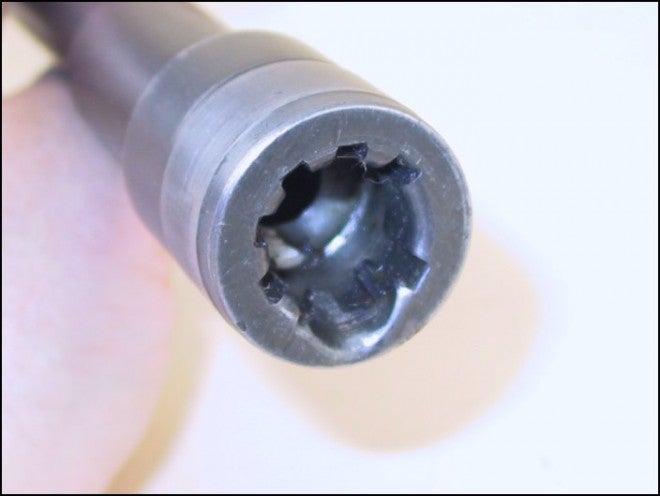
The barrel extension of a Dutch-contract M1941 Johnson rifle. This design, and the bolt that mated to it, was incorporated with Johnson’s assistance into Armalite’s post-war AR-10, and later AR-15 designs. Image source: gunauction.com
After the rifle’s early demonstrations, Johnson began to distrust detachable box magazines, and modified his original prototype to utilize a rotary magazine of his own design. This distrust was in part spurred by his suspicion that Army officials were deliberately using faulty magazines when testing his rifle, to cause the rifle to malfunction more frequently. His accusations of deliberate meddling have never been verified, but his rejection of the detachable box magazine represents a common thread in small arms development during the period; one that would even continue well into the 1950s during the NATO rifle programs. There are many fascinating details of Johnson’s struggle with US Army Ordnance, and I highly recommend readers pick up a copy of Bruce Canfield’s Johnson Rifles and Machine Guns: The Story of Melvin Maynard Johnson, Jr. and His Guns if they wish to learn more than what is covered in this article.

A Dutch contract M1941 Johnson. This designation was actually assigned by the Dutch military, though the rifles were never used by the forces of the Dutch government-in-exile. Low hundreds of these were used by the United States Marine Corps before their acquisition of M1 rifles, and further hundreds (possibly over a thousand) were used in the failed Bay of Pigs invasion of Cuba, post-war. Tens of thousands of rifles were made, and as a result large numbers still exist on the commercial market in essentially brand new condition, like this one. Image source: rockislandauction.com
Johnson’s rifle would eventually meet with some modest level of success: In 1941 the rifle gained a contract with the Dutch government-in-exile for use in the Dutch East Indies. Johnson bought a textile factory, formed a company named “Cranston Arms”, and produced 22,000 rifles and several thousand of his (for the period) excellent light machine guns. However, the Dutch East Indies were overrun by the Empire of Japan before the weapons could be shipped, and the shipments were embargoed. The Marine Corps, desperately in need of light machine guns and other weapons, negotiated to purchase a quantity of the M1941 Johnson Light Machine Guns that had been embargoed, and these were used by Marine parachute and later Marine Raider units in the early Pacific skirmishes. 23 Johnson rifles were also “lent” by Melvin Johnson to the Marine First Parachute Battalion, seeing action in the Solomon Islands campaign, especially the Battle of Guadalcanal, where the rifle achieved a lasting reputation.

The M1941 rifle field stripped. The multi-lug rotary bolt can be seen, as well as the action spring and its guide. The guide acts as an operating rod, acting on the cam slot of the bolt to unlock it. The poor mass ratio of Johnson’s rifle would be thoroughly remedied in its Armalite descendants. Image source: usmilitariaforum.com
As a final note on the Johnson’s history, some of the embargoed rifles were later supplied to the troops of Brigade 2506, for the ill-fated CIA-sponsored invasion of Cuba via the Bay of Pigs. In many photographs of the Brigade in training, the invasion, and its aftermath, the Johnson M1941 is present, suggesting it was a major propaganda piece for the Brigade. The actual composition of weapons used in the invasion appears to be non-homogeneous, but there certainly did exist enough surplus M1941 rifles to arm all 1,300 troops for the invasion.
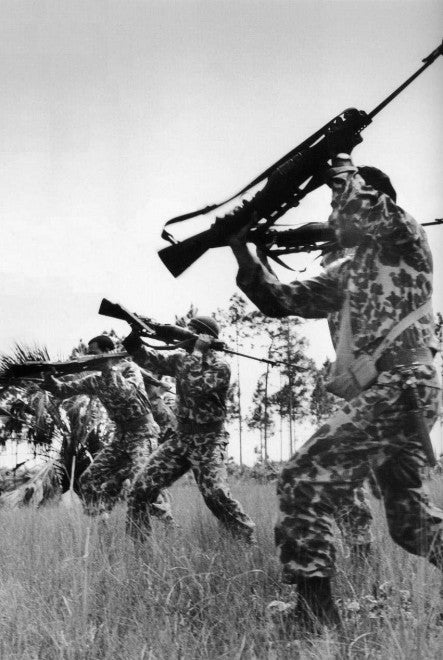
M1941 rifles being used in close-quarters training by members of Brigade 2506. Image source, usmilitariaforum.com.
The Johnson rifle is intricately tied to the history of US selfloading rifle development, both before and after the war. It was one of the first real competitors to the M1 Garand, and the only one to be produced in large quantities or see combat. Further, the rifle was a heavy influence on post-war infantry rifle projects, such as the Army’s experiments in the mid-1950s that mated Johnson’s rotary magazine design to the M1, and more importantly the Armalite series of automatic rifles, on which Melvin Johnson consulted. Both of these projects will me more thoroughly discussed in later installments of this series.
Other rifles, such as Pedersen’s Garand-like GX and GY rifles, sought to compete with the M1 Garand for contracts with the United States government during the pre-war period, but one other deserves some elaboration here as being particularly relevant to effort to develop a lightweight full-caliber rifle. The Winchester G30 began as an effort by Jonathan Edmund “Ed” Browning to produce a selfloading military rifle, which he submitted to Washington for tests in 1938. Winchester CEO Edwin Pugsley witnessed the rifle being tested, and though it was obviously flawed, bought the prototype and hired Browning to work at Winchester refining his design.
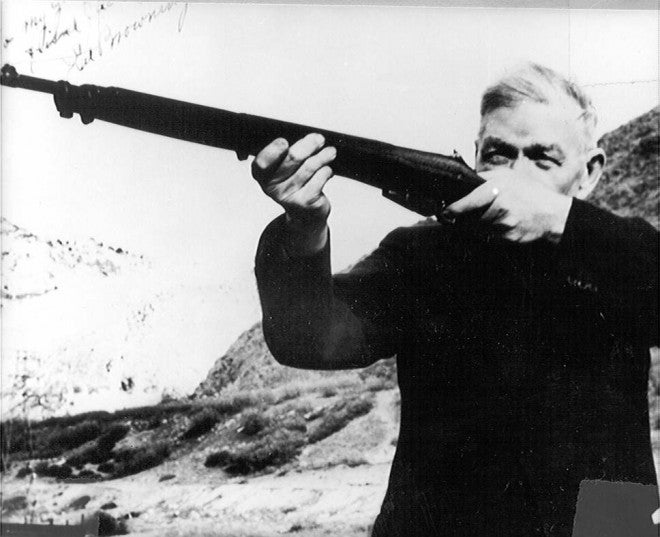
Jonathan Edmund “Ed” Browning, firing the first prototype of what would later become the Winchester G30 rifle. Image source: familysearch.org
The original G30 locked via an upward-tilting breechblock similar in concept to the pivoting breech lock used in the successful Browning Automatic Rifle designed by Ed’s more famous brother. Initial prototypes of the rifle utilized an annular “doughnut” piston that did not give the weapon enough power for sure functioning, but Winchester had recently come into intellectual property of an operating mechanism designed by convicted murderer David Marshall Williams, which would later be incorporated into the famous M1 Carbine. After Browning’s death in 1939, engineers at the company set to modifying his rifle to take William’s fast-moving tappet piston, a modification which according to Pugsley “put new life” into the design. At the same time, the US Marine Corps was eyeing developments in selfloading rifles carefully, and decided to conduct a challenging series of tests of the three most obvious candidates, against the incumbent M1903 Springfield. The tests commenced on the 18th of November, 1940, in San Diego pitting the M1 Garand against the Springfield and both the Winchester G30 and Johnson rifle.
The Marines had special, more stringent requirements for infantry rifles related to the organization of the Corps and its doctrine. Operating from ships and landing craft, a Marine rifle needed to be effective in salt spray, sand, and other conditions that could readily put an early selfloading rifle out of action. The smaller unit sizes of the Corps meant the reliability of each individual weapon was more important – there would be fewer rifles to take up the slack if one went down. Because of these special needs, the tests conducted at the end of 1940 constituted one of the harshest trials that had ever been conducted on semi-automatic weapons to that date. The results showed all selfloading rifles well behind the M1903 Springfield in dependability, but far ahead of it, too, in firepower. Each selfloading rifle had an order of magnitude more stoppages and parts breakages than the bolt-action, and the test conductors wrote what could certainly be perceived as a scathing review of the selfloading rifle in general. Despite this, by March 5, 1941, the Marine Corps had adopted the M1 Garand, the best performer out of all the selfloading rifles in the test, as its new standard-issue rifle. M1s would not be issued to Marines in quantity until 1943, however, as the demands of the Army took priority.
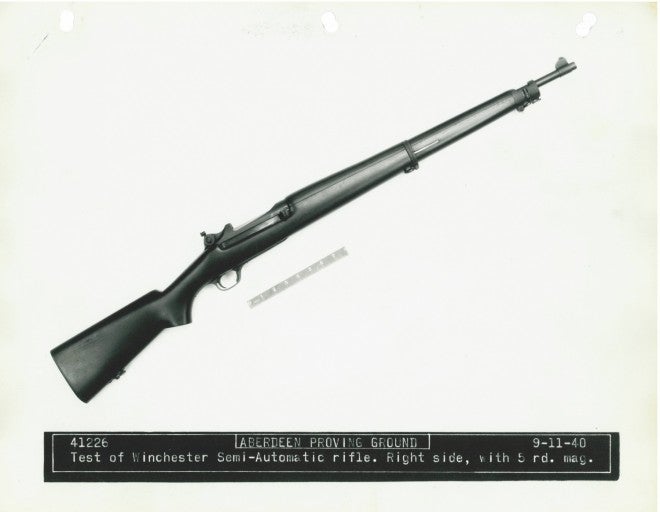
The Winchester G30M. This rifle participated in the USMC tests in San Diego in November and December of 1940. It marries the upward-tilting bolt, forked operating rod, and detachable 5-, 10-, or 20-round box magazines of Ed Browning’s G30 rifle with the excellent tappet gas operating mechanism designed by convict David Marshall Williams. Image source: forgottenweapons.com
The Winchester G30 suffered approximately double the number of malfunctions and parts breakages of either the M1 or Johnson in the San Diego tests, but was much closer to the other two selfloaders than any of the three were to the M1903, and it was noted that the G30 was by far the least well-developed design. As a result, Winchester engineers took the promising weapon back to the drawing board, and put Williams in charge of creating a new rifle that would improve on the G30’s already promising performance. The rifle was called somewhat optimistically “M2” by Winchester, and it had very little in common with the original Browning design, having a Garand-like rotating bolt in place of the upward-pivoting breechblock, and incorporating Williams’ tappet mechanism. As Williams was working on the new design, the US Army Ordnance Department issued specifications for a new “light rifle”: a program unrelated to the subject of this series that resulted in the M1 Carbine, which was produced in larger numbers than any other US weapon during WWII. The company had already begun production of the M1 Garand rifle by this time, and so the Winchester engineers’ focus shifted to work on what would become the famous Carbine.
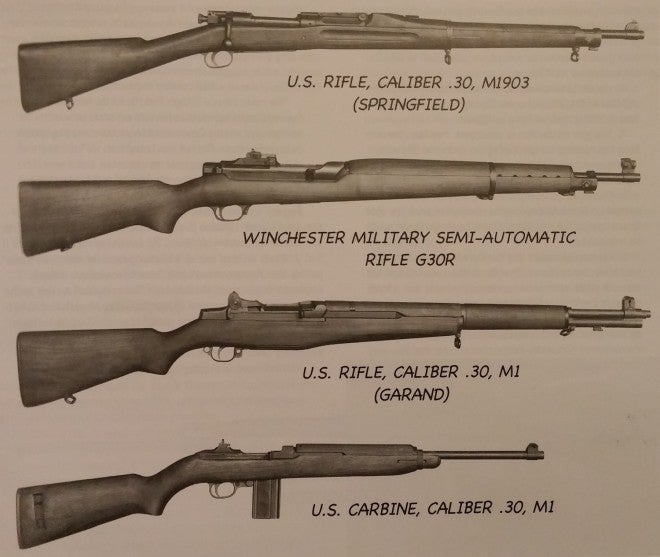
The G30R, compared to the M1903, M1 Garand, and M1 Carbine. The G30R was lighter than the M1, at about seven and a half pounds, and fed from detachable 5-, 10-, and 20-round magazines. A select-fire automatic rifle variant, called the WAR, was developed in 1944. Image source: The M1 Garand Rifle, by Bruce Canfield
The Winchester rifle’s story does not end there, however. The M2 project would be restarted in 1943, after the Winchester carbine had won the Light Rifle competition, and this renewed development would result into a weapon that in many ways heralded the later Lightweight Rifle. The Williams design had been designated in the company’s internal system as “G30R”; despite having little to do with Browning’s effort, it was still considered to be a part of the same lineage. It was an elegantly light weapon, cutting from the Browning design’s 9.2lbs to just 7.5lbs, coincidentally only half a pound more than the program goal of the later Lightweight Rifle effort. Further, the G30 family from the beginning fed from detachable box magazines, and early on 20-round capacity units were produced for trials. Therefore, even at this early stage, in 1943, the Army had available to it a promising design that could have led to a “Lightweight Rifle” that fully or closely met the weight and rate of fire requirements Ordnance would eventually set for the post-war rifle program. Indeed, by 1944 Pugsley seemed aware of the way the winds of Army Ordnance preference were blowing:
There is beginning to become apparent a feeling that the .30-06 (.30M2) cartridge is heavier than necessary for a shoulder arm and that this might be used merely as a machine gun cartridge and a somewhat lighter cartridge developed for use in a lighter semi-automatic rifle.
The lightness of the carbine and its ammunition have contributed greatly toward changing the views on the weight of the Garand and its present cartridge. Ordnance engineers have told me on recent visits to Washington that it is their belief a semi-automatic military rifle weighing about seven pounds, to fire a cartridge very similar to the .300 Savage, would have a very warm reception.
With the semi-automatic, lightweight G30R on hand, Winchester seemed well-prepared to meet such a requirement. However, in the mid-’40s, Ordnance was more interested in the G30R as a potential replacement for the aging BAR in the automatic rifle role. As a result, Winchester modified the design with an automatic fire mechanism that would also be incorporated into the select-fire M2 Carbine, and renamed it the “Winchester (sometimes “Williams”) Automatic Rifle”, or “WAR”. The previously svelte rifle tipped the scales fully loaded in automatic rifle guise at 16lbs, 3 ounces, a weight considered marginal for automatic fire comfort. With the end of the Second World War, development of the Winchester Automatic Rifle was dropped, though the mechanism would be resurrected yet again for Winchester’s entry into the small caliber contest, the Lightweight Military Rifle.
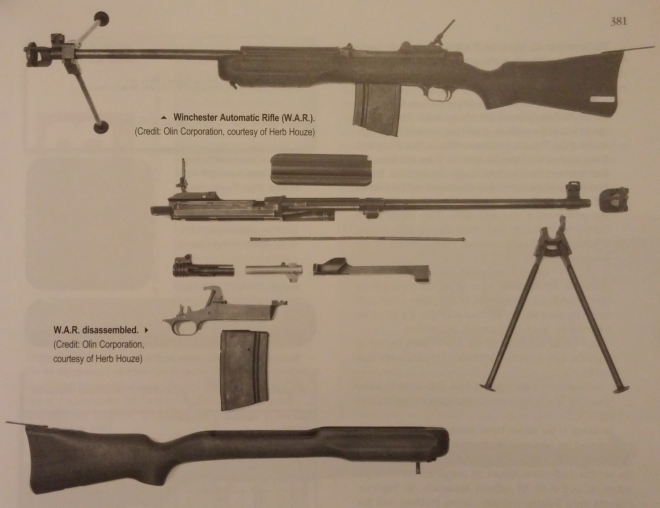
The Winchester Automatic Rifle. This 16lb automatic rifle was intended to replace the M1918A2 BAR, but development was ended with the conclusion of hostilities in 1945. Image source: The M1 Garand Rifle, by Bruce Canfield
The Johnson and Winchester rifles were both the products of great talent that existed among American firearms designers in the 1940s, which the Army was not wise enough to exploit when the dust settled after the end of World War II. Even though neither rifle were so unambiguously superior to the M1 as to render it obsolete, the fact that both rifles were at the least competitive with Garand’s design, and that both were developed without the direct action or endorsement of the Army, hinted that great improvements could potentially be made in the development of selfloading weapons beyond simply iterating the existing M1. The Army was not entirely blind to this, as we will see in later episodes, though they would fail to tap directly the talent of either Johnson or Williams after the war. A more thorough discussion of Johnson’s involvement at Armalite will be given later, but it should be emphasized that the potential of his work in particular is not speculative: Johnson would in no small part be responsible for the creation of the AR-10 rifle, later developed into the venerable M16 family that has served continuously as the standard weapon of the US Armed Services for nearly half a century.
 Your Privacy Choices
Your Privacy Choices